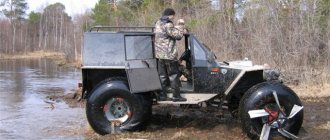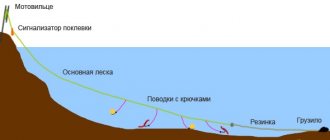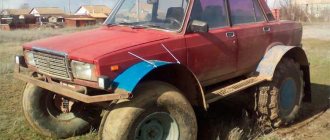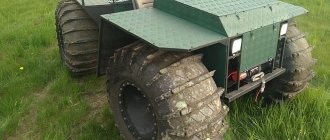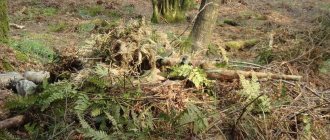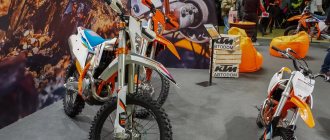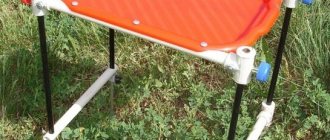Top 5 amphibious all-terrain vehicles
When purchasing such a vehicle, they take into account the purposes for which it will be used. The rating of the best all-terrain vehicles will help you choose a model that can move through swampy areas, forests, shallow rivers, and snowdrifts.
"Trackol"
Russian snow and swamp-going vehicles are manufactured using modern technologies and components. The transport is highly maintainable, which is rarely found in foreign-made models. A broken part can be replaced with your own hands. "Trekol" easily overcomes the following types of obstacles:
- marshy areas;
- beds of shallow streams and rivers;
- lake surfaces;
- snowdrifts.
All-terrain vehicles of this brand are used not only for hunting and fishing, but also for exploring northern regions and taiga forests, building new industrial roads, and conducting survey work. Private users purchase Trekol for off-road travel.
The improved model is the most popular snow and swamp-going vehicle. The machine combines reasonable price, reliability and maneuverability. There are 18 passenger seats, 6 of which are sleepers. Loading capacity reaches 4.5 tons. The powerful engine is easy to operate and repair. The machine operates smoothly in conditions of severe frost and heat. 2 fuel tanks allow you to travel at least 1000 km without refueling.
At the buyer's request, the body is equipped with additional equipment to ensure comfort on long trips. The advantages of MTLB include the following characteristics:
- the presence of textolite inserts in the air cushion housings that prevent early wear of the balancers;
- durable metal hatches and bottom;
- protection of the body with a thick metal pipe;
- comfortable large doors making it easier to board and disembark passengers;
- insulated passenger compartment;
- possibility of installing a roof rack;
- presence of branch splitters.
How to drive a swamp rover
All types of Dobrynya all-terrain vehicles are controlled using 2 steering levers and a two-piston disc brake system with hydraulic drive. These swamp vehicles do not require special driving skills, so it is enough to have a driver’s license of any category so that you can confidently move through swampy areas, reliably maintaining the vehicle’s balance.
All types of internal combustion engines are equipped with a forced air cooling system and the ability to start the engine manually in case the battery fails. Small sizes, high-quality assembly and a high degree of reliability make Dobrynya all-terrain vehicles the best in their segment both in terms of speed and driving characteristics.
How to make an amphibious all-terrain vehicle with your own hands
At home, you can make an amphibious all-terrain vehicle on an air cushion with your own hands. Load capacity reaches 250 kg. The hull has the appearance of a boat, made of fiberglass that can be sanded and painted. For a simple car model, a 15 hp engine is suitable. With. To control the swamp, 2 rear shanks are used, installed above the fan. The propeller is mounted on the engine.
A homemade vehicle has a simple design, which is shown in the drawing before assembly begins. A running motor drives a fan, which creates a powerful flow of air forced under the pillow. Under pressure, the body rises 15-20 cm above the water surface. Part of the air flow is discharged outside, giving the device acceleration. The highest speed of such a car is 60 km/h, fuel consumption is 10 liters per 100 km.
Basic data "Katama"
| Maximum length, m | 3,70 |
| Maximum width, m | 1,50 |
| Side height at midship, m | 0,65 |
| Maximum boat hull draft, m | 0,20 |
| Weight, kg: | |
| housings with control mechanisms and power transmission | 225 |
| axle frames with wheels | 135 |
| motor “K-750” (nominal power 27 hp at 4600 rpm with forced air cooling) | 65 (50) |
| Four-bladed propeller with a diameter of 200 and a pitch | 242 mm |
| Tire size | 50X10″ |
| Total gear ratio in fourth gear: | |
| on the screw | 1,23 (1,88) |
| on wheels | 5,3 (6,2) |
| Travel speed, km/h: | |
| boats | 37 (16) |
| amphibians on water | 7,0 (5,5) |
| amphibians on the highway | 80 (60) |
Note: in parentheses are the values for the version with the Java-350 engine with a rated power of 16 hp. With. at 4500 rpm.
The project of our “Katam” is based on the idea of creating a design in which the hull of a planing tourist boat could, if necessary, serve as the load-bearing body of a miniature amphibious vehicle, which, unlike most designs known to us, has a removable chassis. We tried to make the connection of the boat hull with the chassis, as well as the connection of the power transmission and control systems, as simple and reliable as possible. An important condition was the need to use the most accessible and easy-to-process materials, inexpensive units and components, and in particular a motorcycle engine.
Naturally, our “Katam” was made in accordance with very specific official requirements and was accepted both by the technical commission for small fleets and by the automobile inspection.
Let us briefly outline the main technical requirements for small-scale amphibians manufactured individually (approved by the State Qualification Navigation and Technical Commission for Small Fleet and the State Traffic Inspectorate of the Moscow City Executive Committee).
1.
In terms of lighting, alarms, visibility limits, braking distance, turning radius, tires, stability, placement of the gas tank and exhaust pipes, layout of the driver's seat, ease of entry and control of the amphibian, the same requirements are imposed as for home-made minicars. The steering must be of an automobile type with a steering mechanism. At a minimum, the instrument panel should have: a speedometer, an ignition switch and a light switch. A windshield wiper (not manual) and a rear view mirror are required.
2.
In terms of distinctive, masthead and tail lights and signal lights, as well as mooring and anchoring devices, means for draining water and fire extinguishing, the same requirements are imposed as for small fleet vessels. Life-saving equipment in quantities corresponding to 60% of the permitted human capacity, and in addition one lifebuoy are required. It is also necessary to have a hook-oar.
The use of individual units, mechanisms and parts of standard cars and motorcycles is permitted.
Any types of layout schemes are allowed: with an engine located in the front and rear; with front or rear wheel drive.
We now turn to the description of our amphibious boat. Its normal passenger capacity is four people (including two children in the rear seats).
The hull is sharp-cheeked, uncut with curved keel outlines of the bow frames - closed by a deck with a cockpit (from sp. 3 to sp. 7) and a stern hatch for access to the engine. The cockpit is closed by a glazed pilothouse with a sliding soft top. The windshield (rear from the Volga car) and side windows of the cabin are fixed in guides made of thin-walled tubes covered with plywood frames. Inside the body, seats are installed on solid elan, laid on flora and forming bottom air boxes. Niches are made in the stern to accommodate the wheels and shock absorbers of the chassis. The engine compartment is sealed; in the bow there is a bulkhead on the shank. 1 dedicated air box with a volume of 110 liters. The total volume of all air boxes is 570 liters, which ensures that the amphibian is unsinkable in the event of flooding of one of the compartments.
When designing the Katam, special importance was attached to increasing the strength of the load-bearing hull, which, when moving on land, absorbs significant forces and impacts from the chassis. We had to abandon the construction of doors, since slots even to the middle of the side sharply reduce the overall strength.
Homemade all-terrain vehicles
A serious problem for residents of rural areas is the ability to travel, since there are practically no roads in remote villages. This issue arises especially acutely during the autumn thaw, spring flood or in winter, when everything around is covered with a meter-thick layer of snow. Do-it-yourself all-terrain vehicles in such conditions are an excellent alternative to any technology.
Therefore, rural residents show great interest in technology that can move on any off-road terrain, through water, snow or swamps. Domestic and imported all-terrain vehicles are simply unaffordable for the majority of the population, so local craftsmen often use used vehicles for these purposes or make all-terrain vehicles literally from what lies under their feet.
DIY mini all-terrain vehicles are not only a means of transportation, they are the calling card of a craftsman, his sleight of hand and technical thinking. Not everyone can assemble equipment with their own hands using an old Oka or a motorcycle engine as a starting material. Sometimes the adjustment of one part can last for more than one week, and the search for the right material takes quite a long time. Fortunately, there are no scrap metal collection points in remote settlements, but abandoned enterprises and abandoned equipment can be found in sufficient quantities.
How to convert equipment?
An all-terrain vehicle in the traditional sense is a vehicle designed to move along mud roads and highways, regardless of their surface. An all-terrain vehicle made from a walk-behind tractor is characterized by small dimensions and light weight.
Before you begin the conversion process, you need to focus on individual aspects. You can create a unit on tracks or on pneumatic wheels. At the same time, the tracked structure is more sophisticated, and you need to know and understand how to operate it.
The next thing that needs to be clarified is where and how the unit will be used, what capacity, and also what load it can carry. Having dealt with these issues, you can begin to create a drawing of the future unit.
You should not take just any motor. It must certainly be with forced cooling. Select walk-behind tractors that have an air or water cooling system. The engine must be powerful enough to be able to move over any terrain without problems.
To use a homemade all-terrain vehicle in winter, choose a 4-stroke engine. It has excellent performance during operation at sub-zero temperatures.
Homemade equipment of folk craftsmen
The main models that are made with one’s own hands are pneumatic all-terrain vehicles, amphibious vehicles, do-it-yourself hovercraft all-terrain vehicles and mini tracked tractors. Today, the most suitable designs for homemade creativity are the following all-terrain vehicle designs:
All-terrain vehicle with low pressure tires
As an example, we can use the design of the inventor Gromov. The vehicle has a body on a breakable frame, which increases its stability and maneuverability. All four wheels are driven, and wide-profile low-pressure tires make the all-terrain vehicle stable in marshy or snowy terrain. This all-terrain vehicle was made based on an engine from a scooter.
Self-made all-terrain vehicles Caracats, based on motorcycles, are widely used. Caracats are champions in cross-country ability, as their wide tires provide a large contact area with the ground. This technique moves well in snow, ice, swamps and can even swim. Pneumatics are an environmentally friendly type of ground transport, as they do not destroy grass cover.
Mechanical part
The engine compartment, located above the frame, contains an engine from the same Zaporozhets, which served as the source for the body of the all-terrain vehicle. True, to work in new conditions it was necessary to turn it “backwards”. Torque from the engine is transmitted to the Zhiguli gearbox. In order to install it, we had to make an adapter that simultaneously acts as a clutch casing and has holes for attaching to the engine and gearbox.
All-terrain vehicle transmission diagram
The mechanism of the homemade transfer case is made on the basis of a differential from the Zhiguli rear axle. To do this, it was necessary to grind the differential housing in order to install a glass with a toothed rim on it. Initially there was no crown on this glass; I had to cut the teeth myself. Tooth modulus 3.5. For such a module we had to order gears for the rest of the transfer case filling. The collar at the end of the cup is designed to attach the ring of the gear, which is pressed onto the differential housing. All these parts are screwed together with screws, the diameter of which is equal to the diameter of the standard screws, but the length is slightly longer. The box body is welded from metal 4–6 mm thick. There are no special holes for changing the oil; for these purposes I use the upper and lower holes for the cover mounting bolts.
The engine, gearbox and transfer case, as well as the gearboxes of the front and rear axles, are located along the axis of symmetry of the car. The gas tank (I don’t know why), holding 35 liters, found its place in the rear of the car under the bottom.
Homemade all-terrain vehicle for all seasons
Today, many car lovers prefer to make an all-terrain vehicle with their own hands. Car designs can be spectacular and unusual, and the development could be the envy of a reputable automobile design bureau. To create such a technique requires a lot of time, certain knowledge and, most importantly, perseverance. Not everyone can afford to spend all their free time on calculations, drawings, searching for the right part and adjusting it. The benefits of an all-terrain vehicle are much greater than those of a regular motorcycle. The biggest advantage of an all-terrain vehicle is its versatility, the ability to be used all year round. With the onset of winter, a pneumatic all-terrain vehicle can easily be equipped with skis and the vehicle becomes a real snowmobile.
How to make an all-terrain vehicle from an ordinary passenger car? To do this, it is enough to purchase any tracked, compatible module, for example “Metelitsa”. The use of such a module allows you to drive off-road. The design of the module has sufficient maneuverability to overcome swampy areas and snowy areas. The module is attached to the vehicle frame, and the cardan is connected to the axle of the tracked module. The installation procedure ends with installing the control unit and checking the hydraulic system.
How often should you wash your car?
There is an opinion that the engine washing procedure is like changing the oil - of course, you don’t have to do it and drive, but there is no guarantee that this will continue for a long time. Oil stains accumulated under the hood do not have the best effect on the operation of electrical equipment and threaten with dire consequences, including a car fire.
Of course, we do not advise you to resort to engine washing services every week, but you shouldn’t completely ignore it, find that golden mean, and, for example, while preparing for the new season, go to a car wash and do something nice for the engine. By the way, now, when you are compiling a list of preventive measures to prepare for the spring-summer season, it is possible that another item will appear on it.
When visiting a car wash, you may be alerted by a notice that the administration is not responsible for problems that may be caused by engine washing. Therefore, maybe you shouldn’t overpay and wash the engine compartment yourself? Moreover, by following our recommendations, you can do it quickly and easily. Let's get started?
Peculiarities
Wheeled, tracked all-terrain vehicles on low-pressure tires: snowmobiles, amphibians, swamp vehicles, station wagons have advantages, in terms of design features, over other types of modern vehicles. Also, compared to passenger cars, they look large, massive and are only very conditionally adapted to travel on public highways. Fans of massive cars designed for off-road travel - soil, water, sand - emphasize the main advantages.
- An incredibly large selection of high-speed models among wheeled and tracked vehicles.
- Supporters of exotic vehicles can purchase auger vehicles or hovercraft.
- You can buy a powerful all-terrain vehicle new, in a store, or used, second-hand.
- There is a huge inherent potential in different types of machines, when it is not difficult to overcome natural or artificial obstacles or difficult climbs.
- The maintainability of the car is beyond doubt. If spare parts are available, such special equipment can be easily repaired even in the field.
The versatility of using domestic and foreign models is beyond praise, when one all-terrain vehicle manages to break through snow drifts in winter, and overcome difficult rough terrain, small rivers, and impassable areas in summer. In principle, modern all-terrain vehicles have few disadvantages.
- High cost compared to conventional passenger cars.
- Dimensions when you have to think about where to park the purchased vehicle.
- Travel options in urban environments.
What is a hovercraft?
This is a device that combines the functions of a car and a boat. The result was a hovercraft (hovercraft), which has unique cross-country characteristics without loss of speed when moving through water due to the fact that the hull of the vessel does not move through the water, but above its surface. This made it possible to move through the water much faster, due to the fact that the friction force of the water masses does not provide any resistance.
Although the hovercraft has a number of advantages, its field of application is not so widespread. The fact is that this device cannot move on any surface without any problems. It requires soft sandy or soil soil, without stones or other obstacles. The presence of asphalt and other hard bases can render the bottom of the vessel, which creates an air cushion when moving, unusable. In this regard, “hovercrafts” are used where you need to sail more and drive less. If on the contrary, then it is better to use the services of an amphibious vehicle with wheels. The ideal conditions for their use are difficult, swampy places where no other vehicle except a hovercraft (hovercraft) can pass. Therefore, hovercrafts have not become so widespread, although similar transport is used by rescuers in some countries, such as Canada, for example. According to some reports, SVPs are in service with NATO countries.
Overview of species
For fishermen, hunters, and connoisseurs of extreme recreation, many different models of SUVs have been invented. Therefore, every lover of driving over rough terrain, as a rule, chooses a car with low-pressure tires, focusing on certain criteria and the capabilities of the car. For example, for fishing it is advisable to buy a light, wheeled SUV that can easily overcome streams and difficult terrain.
With such a vehicle you can safely go fishing and load a large amount of gear and even a small boat into the back.
For hunting, it is better to buy floating models of special equipment with the ability to move through hard-to-reach areas . A six-wheeled covered all-terrain vehicle will be a versatile and successful purchase, because most hunters, as a rule, go for prey for several days in remote places that do not have a large number of asphalt roads. On the way to the goal, you may encounter wide streams, shallow rivers, steep, swampy areas, descents and ascents that must be overcome.
Craftsmen assemble skid steer vehicles on ultra-low pressure tires with their own hands. The all-terrain amphibious vehicle "Sherp" can serve as a base for copying. The distinctive advantages of powerful SUVs are as follows.
- Steel body.
- Huge wheels 160 cm.
- All-wheel drive, manual transmission.
- Overcoming obstacles up to 70 cm high.
- Ability to move on water.
- Towing a trailer weighing up to 2.4 tons.
The models are produced in two modifications - kung and standard. Modern Kulibins often assemble pneumatic all-terrain vehicles with their own hands, based on some broken down car, or invent their own design. To make this modification you will need:
- engine from VAZ eighth model;
- Manual transmission from VAZ 2109;
- bridges from GAZ 24 and Niva;
- Ural wheels;
- cardan from Niva.
Also, in addition to a large number of tools, you will need additional components, parts, consumables, galvanized steel, profile pipe, hydraulic cylinder. On domestic roads you can sometimes see quite interesting models, mini-all-terrain vehicles from folk craftsmen. These can be four-wheeled or three-wheeled options. They, as a rule, have wide low-pressure tires, an open top, and an engine from a motorcycle or walk-behind tractor. On such all-terrain vehicles you can go on summer and winter fishing, and ride over rough terrain.
Swamp walkers
It is known that Russia is famous not only for its large number of roads, but also for the directions in which you need to somehow get around. Therefore, such powerful SUVs are intensively used by special services, as well as by those who like to drive through hard-to-reach areas. A good example of such special equipment is Trekol.
What is a typical swamp bug? This is a powerful all-terrain vehicle, usually on low-pressure tires, which is able to overcome difficult terrain, water obstacles, and wetlands. That is, he will be able to drive through areas where a regular SUV would get stuck.
For example, on the Trekol model you can even cross a small lake.
Who usually buys a swamp vehicle?
- Fishermen, hunters, rural workers, farmers (a car can always replace a tractor).
- Huntsmen, loggers, foresters.
- Special services to save people.
- Polar explorers, geologists, oil workers.
The key disadvantage of swamp vehicles is their high cost, but this does not stop true lovers of extreme recreation.
Snowmobiles
They are of considerable interest to military and civilian services. Snowmobiles are also purchased by winter recreation enthusiasts. The main advantages of powerful SUVs:
- relatively simple machine design;
- high cross-country ability in snowy areas;
- engine maintainability;
- reliability of operation in extreme conditions;
- comfort for the driver and passengers (usually 2 stoves for heating the cabin).
The most famous model is the Berkut snowmobile. In this modification, it was possible to implement intuitive control using a steering wheel, a manual gearbox, and three pedals. An indoor snowmobile in snowy areas can reach speeds of up to 35 km/h. Thanks to the tracks, it can easily overcome horizontal slopes of up to 30 degrees. Regarding the height of snowdrifts, the all-terrain vehicle has no equal here. The Golden Eagle is not designed to travel on highways.
Delivery of vehicles to their destination is carried out by trucks. If desired, the car modification can be equipped with a satellite navigation system.
Homemade amphibious vehicle Ichthyander
February 14, 2017 08:29 USSR homemade amphibian
Amphibious cars are the brainchild of home-made people - a kind of embodiment of the dream of a universal car capable of driving, swimming and almost flying.
See all photos in the gallery A truly viable amphibian design was created by an engineer, a specialist in coal combines, Igor Rickman. His floating car has proven itself well on the water and on the roads, being in no way inferior to an ordinary car on the roads, or to a motor boat on the water. I. Rickman's amphibian successfully participated in many runs of amateur designs, and was filmed in feature films. The design can certainly be of interest not only for DIYers, but also for industry. The tandem Igor Rickman and Alexey Revyakin began work on the amphibian in 1971. The amphibious vehicle was tested in 1979 during a run of home-made structures, which it withstood with dignity.
The car body is sheathed in aluminum. To ensure better tightness, the design is doorless. The bottom contours are modeled after the Kama boat, which has a beneficial effect on the hydrodynamic characteristics of the vehicle. The inside of the hull is covered with foam plastic to improve buoyancy; special cavities filled with foam plastic are also provided for this purpose. The case is divided into three waterproof compartments.
The front compartment contains the trunk, brake and clutch master cylinders with brake fluid reservoirs, batteries and steering. Two rods and a pendulum lever were added to the steering design, taken from the 968 Zaporozhets. Of course, all parts coming out of the housing have seals to prevent water from entering the housing. On the hood of the front compartment there is an anchor connected by a cable to a winch, which has both an electric and manual drive.
In the middle, the largest compartment, there is a car interior with controls. Access to the interior is provided by a canopy that slides back. To facilitate penetration inside through the high side, there are recesses on the sides.
The “engine room” was located in the aft compartment. A VAZ-2103 engine is installed in the rear overhang, connected through an adapter plate to a gearbox from a Zaporozhets ZAZ-966. The engine cooling system uses three radiators: two traditional air-blown ones and one mounted on the bottom, cooled by water during sailing. Air intakes for cooling the radiators are located on the rear pillars. “Ichthyander” is equipped with independent torsion bar suspensions on all wheels. The suspension design uses couplings to regulate ground clearance. Thus, in water, the wheels can be pressed inside the arches, thereby reducing water resistance. For the same purpose, the rear wheels are covered with special curtains. The suspensions are built using ZAZ-968 front suspension units. Tightness is ensured by dense elastic gaskets and oil back pressure created by a reservoir located above the waterline. The propulsion device for the amphibian in water is a hydrojet single-stage axial water jet. It is connected to the front end of the engine crankshaft (where the starter handle ratchet was on the old Zhiguli) through an elastic coupling. On the water, the amphibian turns by turning the front wheels and the outlet nozzle of the water cannon. A hydraulic reverse is also provided for reversing. The amphibious vehicle reaches land with acceleration. If the shore is steep or the bottom of the reservoir is too muddy, then an anchor fixed to the shore is used to drive out onto land, then with the help of a winch the car is pulled onto the terra firma.
On the highway, “Ichthyander” confidently moves at speeds of up to 120 km/h; on water, the speed reaches up to 20 km/h.
He made the second amphibian, Ichthyander-2 (which will be discussed below), in the early 1990s.
The dimensions of the amphibian are larger than those of the Volga GAZ-2402 (slightly longer and 350 millimeters wider, that is, the dimensions of a minivan). In terms of driving performance, this is an all-terrain (and even high) cross-country vehicle (nowadays such cars are called SUVs) with all driving wheels and locking differentials. In addition, it has adjustable ground clearance depending on road conditions.
The body shell is fiberglass; its total thickness is about 8 mm. The gluing was done from fiberglass on epoxy binder in two layers.
First, using a frame of thin-walled steel (2 mm) square pipes with a cross-section of 25×25 mm, an outer shell layer about 5 mm thick was formed using the sliding formwork method. Then I lined the pipes with foam pads and pads.
80 hp engine used from VAZ-21213. As you know, it is intended for cars with a front-mounted power unit. Therefore, it was necessary to redesign and modernize the engine cooling system. Firstly, the radiator was located in the stern to the left of the engine, and the fan impeller was mounted on the generator shaft.
An additional electric fan was also installed here. Air intake occurs through the side grilles in the body panels, and exhaust through the rear grilles. Since forced ventilation is exhaust, there is no smell of not only exhaust gases, but also gasoline in the cabin even when parked.
The exhaust tract elements, including the muffler, are also located here.
The gearbox unit together with the clutch, as well as the front differential with the final drive, come from a LuAZ car. They abandoned the Luaz wheel gearboxes: after all, the amphibian is a high-speed vehicle.
The brake system (cylinders, amplifier, discs, etc.) is basically used from the VAZ-2121 Niva car. But the rear brakes are made of discs (they dry out faster when leaving the water). In addition, the parking brake is also hydraulically actuated.
The most interesting thing in this story is that the car was sold...to the Germans!
Two amphibian enthusiasts from Germany saw the car for sale and came to Russia to buy it.
Aquaped amphibian
The family of pedal boats is diverse and numerous, but they all have a significant drawback: transporting them overland is very difficult. Another thing is the amphibious aquaped; he feels just as confident on land as on the water. The secret of such versatility is in its propulsion - the crankshaft with paddle wheels is the driving “front axle” when traveling on roads.
Making an amphiped is not that difficult. Start your work by making the frame of the boat. Glue the frames from pine slats with a section of 13x35 mm, reinforce the joints with plywood gussets and screws. Cut the transom board from a sheet of plywood 12-15 mm thick. Its dimensions are 220x900 mm. For the longitudinal set of the body, prepare four slats with a cross-section of 20x20 mm, two with a cross-section of 15x35 mm and one with a cross-section of 35x35 mm. The length of each rail is 2000 mm. For the keel, you will also need a 15x35x1330 mm strip.
Rice. 1. Three-wheeled amphibian: 1 - swivel unit, 2 - seat, 3 - steering wheel, 4 - amphibian drive wheel, 5 - body, 6 - crankshaft, 7 - steering cables, 8 - steering drum.
A few days before assembling the frame, the blank for the keel beam (35x35 mm cross-section) should be soaked in water (for two days), and then fixed on a slipway - a board about 40 mm thick. The deflection of the beam must correspond to the configuration of the bottom. After drying for two to three days, the workpiece is placed on a flat horizontal platform and secured with small nails. Mark the location of the frames with a colored pencil or felt-tip pen and cut grooves in the marked places. Install the transverse set elements on the keel beam and temporarily secure them to it. Next, in the corners of the frames and transom board, make holes for the longitudinal slats. The frame is assembled using polyvinyl acetate or casein glue and screws. When assembling, carefully check the relative position of the elements of the longitudinal and transverse sets, avoiding distortions. The remaining longitudinal elements of the set are adjusted in place, that is, the lath is applied to the frames, its position on them is noted, and then the grooves are cut.
Rice.
2. The body of an amphibious aquaped. After cleaning the frame, cover it with plywood or hardboard. Start from the bottom. Attach a blank (4x1000x2000 mm) to it, outline it along the frame with an allowance of 3-5 mm on the side and cut it. Next, lubricate the joining surfaces with glue, place the trim on the frame and, starting from the transom, use nails about 20 mm long to nail it to the parts of the set. When the glue has dried, carefully smooth the contours of the sheet with a plane. Cover the sides and deck in the same way. Carefully treat the joints from the outside and smooth the inside with epoxy putty. Along the outer contours it is useful to additionally cover the boat with fabric in one layer. It can be glued with any resin, including parquet varnish, as well as GF and PF paints.
Now let's take on the rowing mechanism. It includes a crankshaft bent from a steel bar Ø 12-14 mm, two bicycle wheels (we recommend using the front wheels of teenage bicycles) and two paddle wheels assembled from six plywood (10 mm thick) or duralumin (3 mm thick) plates each .
Rice. 3. Structure of the front axle of the amphibian: 1 - wheel (from the Shkolnik bicycle), 2 - deck, 3 - cockpit edging, 4 - pedal (plywood or textolite), 5 - central support bearing (brass or copper S2), 6 - crankshaft (steel 0 12-14 mm). 7 — bracket for fastening the propeller plates (duralumin corner 20×20 mm), 8 — propeller plate (S10 plywood or S3 duralumin) 9 — figured plate, 10 — side reinforcement (S12 plywood), 11 — bushing bearing (brass, bronze) , 12 — keel beam, 13 — support for the central and steering bearing. 14, 15 - longitudinal frame set.
The dimensions of the rowing plate are 150x250 mm. It is secured to the wheel rim with duralumin corners and pins with a countersunk head. In the center, the propeller plates are assembled using a shaped duralumin plate 2 mm thick. Secure the crankshaft support bearing to a trapezoidal wooden block 35 mm thick, sheathed on both sides with 4 mm plywood. Screw the steering column bearing to the block - a steel bracket with holes, bent from a 4 mm thick strip. Fix the steering column - a duralumin pipe Ø 20-22 mm - in the bearing with two cotter pins.
It is advisable to use a ready-made steering wheel, but you can make it yourself by bending it from an aluminum pipe with a diameter of about 20 mm, or use a ring from an old Viennese chair. Cut the spokes of the steering wheel from a duralumin sheet about 3 mm thick. Turn the central bushing on a lathe or select a suitable block. The rear steering wheel (from a children's bicycle or stroller) is mounted on a swivel bracket welded from the front of an old bicycle frame and a steel plate. It is secured to the transom board with four bolts. The steering drum is a round wooden boss Ø 100 mm with two duralumin cheeks. To control the amphiped on the water, a duralumin steering feather is provided, hingedly mounted on the rear wheel axle. Before the car leaves for land, the feather is raised and secured with a cable and a carabiner.
Rice. 4. Steering device: 1 — steering wheel, 2 — steering shaft, 3 — cotter pin with washer 4 — bracket, steering bearing (S3 steel), 5 — central support bearing, 6 — support, 7 — keel beam, 8 — bottom plating .
To wire the steering cables, you will need four to six blocks: these are available in any children's construction set. You can adjust the tension of the cables using a pair of lanyards (tanders). The amphiped seat is a wooden frame covered with a nylon cord or a vinyl chloride tube Ø 5-6 mm. When installing the seat in the boat hull, make sure that its position can be adjusted depending on the height of the driver. Having completed the assembly work, putty the body inside and out and paint it in two or three layers with GF or PF enamels. That's all.
All that remains is to test the amphibian in both land and water versions, once again check all the joints and bearings, and eliminate possible leaks.
Homemade amphibians: made in the USSR
An amphibious vehicle, although a useful thing, is difficult to access (especially in Soviet times). And if you can’t get something, then you can do it yourself. Let's look at the Soviet Kulibin amphibians
An amphibious vehicle, although a useful thing, is difficult to access (especially in Soviet times).
And if you can’t get something, then you can do it yourself. Let's look at the Soviet Kulibin amphibians. "Triton"
The creator of Triton, Dmitry Kudryachkov, set himself a difficult task - to achieve operational equivalence of the amphibian when used both on water and on land. It was clear from the very beginning that with all options for solving “land” problems, the amphibian’s planing contours, which guarantee full speed, must remain intact. So the Triton looks like an ordinary boat - but with wheels. The GAZ-21 engine, as well as a homemade gearbox and gearbox with a differential from a ZAZ car, form a single power unit. On the Triton highway it was possible to accelerate to 100 kilometers per hour. The maximum speed on the water was not measured, but according to the designer, the amphibian is capable of swimming at a speed of 48-50 kilometers per hour. So it is quite possible to say that Dmitry Kudryachkov coped with the task set at the very beginning one hundred percent.
"Martin"
No matter how many car enthusiasts call a car a “swallow,” it’s unlikely that anyone loves their car more than Ivan Egorov from Novokuznetsk. After all, he made this “Swallow” himself. The master began work in 1958. At first I had to work in a room in a poorly equipped barracks. In 1961, Ivan Evdokimovich got a garage, opposite which he built a workbench on which the car was built. The main components and assemblies are taken from various Soviet cars: the engine, for example, is all from the same GAZ-21 (with which the designer managed to accelerate to 120 km/h on land). But Ivan Egorov made all the small details by hand - he even sewed the seat covers himself. The “Swallow” received a license plate in 1988, only 23 years after the creation of the car - almost all of this time was spent overcoming bureaucratic barriers. As for the aquatic life of “Swallow,” although she can swim, she doesn’t really like it: the last time Ivan Egorov swam across the Tom River in his car was about forty years ago.
«Floating Carlson"
“Floating Carlson” got its ridiculous name because of the propeller from the boat, which is located directly under the rear bumper. This car is familiar to native Novosibirsk residents who remember the 80s and 90s. Then “Carlson” drove around the city almost every day. The car was built by Novosibirsk resident Grigory Ilyich Khokhlov. When building the amphibian, spare parts from five cars were used - Pobeda (Gaz 20), Volga Gas 21, Volga Gas -24, UAZ 469 and GAZ -69. The sealed body was made by the designer himself. “Floating Carlson” has all-wheel drive, a five-seater cabin and a GAZ engine that develops 85 horsepower and accelerates the homemade car to 110 kilometers per hour.
"Ichthyander-2"
The father of the “Sea Devil”, Igor Rickman, is the former chief designer of coal mining machines at the USSR Ministry of Coal Industry. “Ichthyander-2” is his second and more successful amphibian. The car body is made of fiberglass and is divided into top and bottom by a rubber mooring beam, which protects the plastic from impacts and completes the exterior design. The roof is liftable, with a huge sliding hatch. The front seats swivel, like in a hair salon, the rear sofa folds out. The VAZ-21213 engine is combined with a modernized “box” from LuAZ. For swimming, a water jet is installed, which is activated via a claw clutch. The amphibian is quite spacious - it can easily accommodate three hundredweight of cargo and seat five people.

